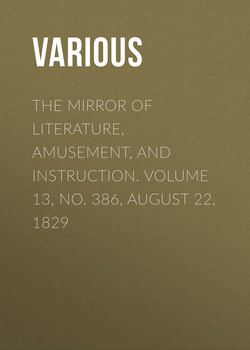The Mirror of Literature, Amusement, and Instruction. Volume 13, No. 386, August 22, 1829

Реклама. ООО «ЛитРес», ИНН: 7719571260.
Оглавление
Various. The Mirror of Literature, Amusement, and Instruction. Volume 13, No. 386, August 22, 1829
ST. PETER'S CHURCH, PIMLICO
PSALMODY
THE LAY FROM HOME
TYRE
LINES ON THE DEATH OF SIR HUMPHRY DAVY, BART. 2
HAMPTON COURT: BIRTH OF EDWARD THE SIXTH, AND DEATH OF QUEEN JANE SEYMOUR
THE NOVELIST
THE HEARTHSTONE.—A GERMAN TRADITIONAL TALE
THE NATURALIST
NEST OF THE TAYLOR BIRD
IVY
MICROSCOPIC AMUSEMENT
NOTES OF A READER
ROYAL PROGRESSES, OR VISITS
SHAKSPEARE'S MACBETH
CHINESE DRAMA
THE HAWTHORN
TURKISH JOKE
FUND AND REFUND
COURT SQUABBLES
LULLABY
GOOD NIGHT
THE ANECDOTE GALLERY
THE EDDYSTONE LIGHTHOUSE
SPIRIT OF THE PUBLIC JOURNALS
LINES
ILLUSTRIOUS FOLLIES
THE GATHERER
BULL AND NO BULL
BAD HABIT
CURIOUS POST OFFICE
AMERICAN COURTSHIP
LIGHT EVIL
Отрывок из книги
The engraving represents the new church on the eastern side of Wilton Place, in the Parish of St. George, Hanover Square. It is a chaste building of the Ionic order, from the designs of Mr. Henry Hakewill, of whose architectural attainments we have frequently had occasion to speak.
The plan of St. Peter's is a parallelogram, placed east and west, without aisles; the east being increased by the addition of a small chancel flanked by vestries. The west front, in our Engraving, is occupied by an hexastyle portico of the Ionic order, with fluted columns. The floor is approached by a bold flight of steps, and in the wall, at the back are three entrances to the church. The columns are surmounted by their entablature and a pediment, behind which a low attic rises from the roof of the church to the height of the apex of the pediment; it is crowned with a cornice and blocking-course, and surmounted by an acroterium of nearly its own height, but in breadth only equalling two-thirds of it; this is finished with a sub-cornice and blocking-course, and is surmounted by the tower, which rises from the middle. The addition of a steeple to a Grecian church forms a stumbling-block to our modern architects, forcing them to have recourse to many shifts to convert a Grecian temple into an English church, a forcible argument for the rejection of the classical styles altogether in this species of buildings. 1 Mr. Hakewill has, however, in part surmounted this difficulty, and the effect produced is not bad, as great value is given to the front elevation by it.
.....
The only instance I have met with in any of the London churches or chapels of the Church of England (there may be others) is at the St. James's Chapel, near Mornington Place, on the road to Hampstead. I attended at that place of worship lately, and was delighted with the whole of the services, wishing only that greater numbers of the congregation had joined in the singing, which was conducted precisely on the principle of four being appointed to lead the congregation: the four voices were excellent, and naturally and easily led many to join, and I cannot doubt, but that this superior arrangement, whoever was the author, will tend to make the singing in that chapel an example to many others.
I lament that I am obliged to leave town, and may not be here again for several months, but when I do, I shall humbly offer my services to the clergyman of the chapel, for the improvement of so judicious a plan, and extending it to other chapels of the same parish.
.....